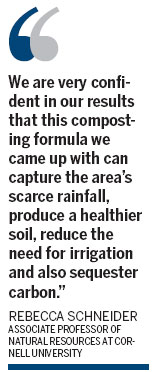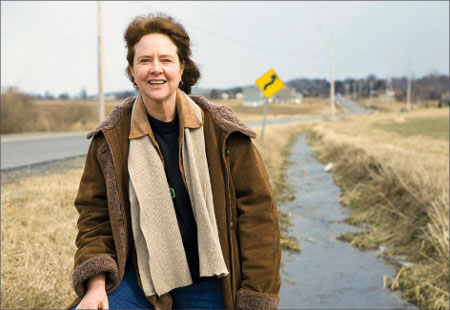Cornell ' formula may help solve Ningxia's soil erosion
Updated: 2013-04-09 11:48
By Caroline Berg in New York (China Daily)
|
||||||||
|
Rebecca Schneider, Cornell University associate professor of natural resources, led a team to the Ningxia Hui autonomous region in northwestern China to study how poplars can help capture water and enhance arid soil. Provided to China Daily |

A compost of wood chips from poplar trees developed by Cornell University scientists may be part of a solution to huge soil-erosion problems in northwest China.
Working in the northwestern Ningxia Hui autonomous region, the scientists developed the compost as part of a three-year $450,00 project funded by the Chinese government.
Rainfall in the region is less than six inches annually, but 36,800 square kilometers of soil erosion in Ningxia causes an average of 100 million metric tons of silt to flow each year into the nearby Yellow River, Asia's second-longest and "the cradle of Chinese civilization".
"We are very confident in our results that this composting formula we came up with can capture the area's scarce rainfall, produce a healthier soil, reduce the need for irrigation and also sequester carbon," said Rebecca Schneider, associate professor of natural resources at the Ithaca, New York-based university.
In August of last year, Schneider led research at the Ningxia Forestry Institute's State Key Laboratory of Seedling Bioengineering in which the local and prevalent white poplar tree was used for the compost and added to the upper soil layer of a testing plot.
The next step is to test alternative soil-enrichment formulas to further improve plant growth, soil nutrients and aid in carbon sequestration.
"The more we bring the grasses back, the less farmers will have to rely on irrigation," Schneider said.
The original research plot has been expanded into an education and extension site for policymakers and the public.
The next phase will also include outreach in one of the region's "harmonious villages," to teach hundreds of thousands of residents relocated from rural areas how to apply the soil enhancement technique in their gardens.
The project was inspired by the International Watershed Workshop that Schneider conducted with two other Cornell professors at Beijing Normal University in August 2011, which caught the attention of scientists who then invited the professors to Ningxia to do research that would help restore the region's soil.
Over the past 50 years, China has lost more than 3.56 million square kilometers, or 37 percent, of its total arable land to soil and water loss, according to China's Ministry of Water Resources.
Lester Brown, founder and president of the Earth Policy Institute and author of Who Will Feed China?, said there's a lot of over-plowing and overgrazing in the upper reaches of the Yellow River basin.
"When you destroy the natural vegetation, and then when it does rain, you get soil erosion with a lot of it ending up in the river," he said.
Brown believes the root of the erosion problem started from 1978 when China began to lift restrictions on livestock production.
"I think the single biggest thing China needs to do is reduce the number of sheep and goats it has," he said.
"What happened was they got a lot of overgrazing in a short period of time," Brown said. "The result is a huge dustbowl forming in the northern part of China today, far bigger than the one we had in [the US] in the 1930s."
China has the world's largest number of goats and sheep with 285.8 million of the livestock, according to a 2008 report by the United Nations' Food and Agriculture Organization.
"I don't think they're going to be able to do much about it because the number of people who own these sheep and goats is so huge," Brown said. "It's a difficult situation for the Chinese to deal with and I fully expect it's going to get a lot worse in the years ahead."
In addition to Schneider, the scientific team includes crop and soil science professor Harold van Es, natural resources professor James Lassoie and senior research associates Stephen Morreale and Ruth Sherman, as well as Li Changxiao, a professor at the Southwest University in Chongqing and a former Humphrey fellow at Cornell, and Li Jian, director of the Ningxia laboratory.
Funding for the project covers the research, labor, equipment, and the US team's travel to China and in-country living expenses.
Schneider said she plans to get Cornell graduate students involved in the Ningxia project and is seeking a grant from the US government to help expand the initiative.
"The people we work with in Ningxia are delightful," Schneider said. "They're really passionate about taking care of their land and conserving their resources."
carolineberg@chinadailyusa.com

 In Photos: 7.0-magnitude quake hits Sichuan
In Photos: 7.0-magnitude quake hits Sichuan
 Li Na on Time cover, makes influential 100 list
Li Na on Time cover, makes influential 100 list
 FBI releases photos of 2 Boston bombings suspects
FBI releases photos of 2 Boston bombings suspects
 World's wackiest hairstyles
World's wackiest hairstyles
 Sandstorms strike Northwest China
Sandstorms strike Northwest China
 Never-seen photos of Madonna on display
Never-seen photos of Madonna on display
 H7N9 outbreak linked to waterfowl migration
H7N9 outbreak linked to waterfowl migration
 Dozens feared dead in Texas plant blast
Dozens feared dead in Texas plant blast
Most Viewed
Editor's Picks

|

|

|

|

|

|
Today's Top News
Live report: 7.0-magnitude quake hits Sichuan, heavy casualties feared
Boston suspect cornered on boat
Cross-talk artist helps to spread the word
'Green' awareness levels drop in Beijing
Palace Museum spruces up
First couple on Time's list of most influential
H7N9 flu transmission studied
Trading channels 'need to broaden'
US Weekly

|

|








